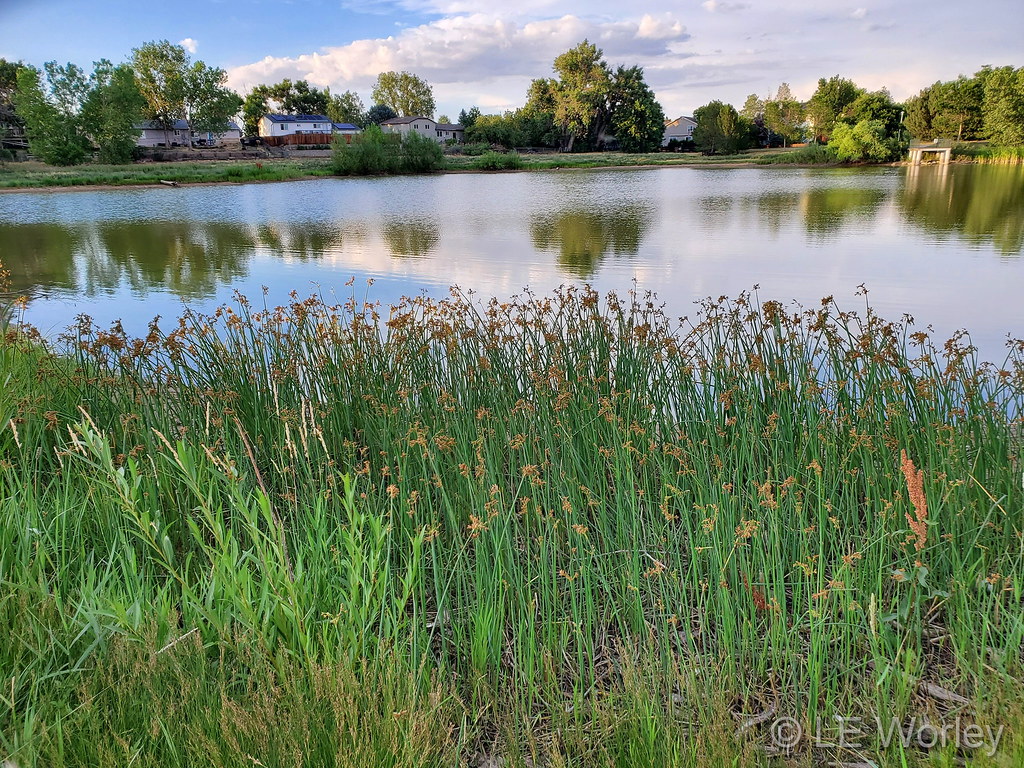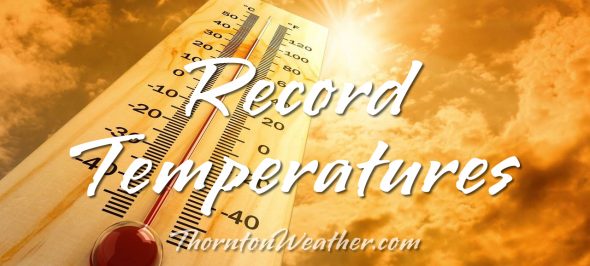On first glance our look at this week in Denver weather history appears to be less eventful than many we have looked at previously. However, the severity of the events that appear on the historical weather calendar this week are enough to make you stand up and pay attention. While August is typically a pretty quiet weather month, it is clear that severe weather can certainly strike and Thornton is mentioned in more than one significant event.
From the National Weather Service:
2
In 1878…the high temperature reached 100 degrees in downtown Denver.
In 1911…an apparent dry microburst produced sustained west winds to 42 mph.
In 1972…one workman was killed and another injured when a strong gust of wind destroyed a partially completed apartment building in south Denver. Hail to 1 3/4 inch diameter fell in Golden.
In 1973…hail to 3/4 inch diameter was reported in Boulder.
In 1986…a major outbreak of severe thunderstorms occurred along the Front Range. Thunderstorms developed explosively. Some places were hit by large hail twice. Two inch diameter hail broke car windows on I-25 west of Brighton…and up to 1 1/4 inch hail broke windows in Thornton. Baseball size hail damaged several planes near Watkins. Funnel clouds were sighted around Aurora. Hail over 1/2 inch in diameter covered the ground 3 to 4 inches deep at Hudson northeast of Denver. Most of the hail fell north of metro Denver…but 3/4 inch diameter hail was measured at Stapleton International Airport. Total damage from the hail storms this day was estimated at over 10 million dollars.
In 1991…late afternoon thunderstorms produced heavy rain across metro Denver. Two feet of water covered parts of I-25 in southeast Denver…while one foot of water covered parts of U.S. Highway 285 in Englewood. Thunderstorm rainfall totaled 0.50 inch at Stapleton International Airport.
In 2001…severe thunderstorms producing heavy rain and hail… Either washed out or damaged several County roads in the Watkins and Bennett areas. A small tornado (f0) touched down near Bennett…but did no damage. Hail as large as 1 3/4 inches in diameter fell near Watkins. One inch diameter hail was measured near Hudson and Keenesburg.
In 2008…strong winds blew several trees down in Denver… Damaging homes and downing power lines. A peak wind gust of 67 mph occurred at Centennial Airport…with gusts to 60 mph estimated in Denver. A peak wind gust of 37 mph was measured at Denver International Airport. An elderly man was killed when a wind damaged tree broke free and crushed him while he attempted to remove it. The downed power lines caused outages to about 500 Xcel energy customers.
2-3
In 1876…grasshoppers were in great abundance in the city and caused considerable damage to gardens and to crops in the surrounding farms and ranches.
In 1951…heavy thunderstorms rumbled across metro Denver through the night. Heavy rain totaled 3.45 inches at Stapleton Airport. This was the greatest 24 hour precipitation ever recorded during the month of august in Denver.
In 2007…heavy rain caused localized flash flooding near Ft. Lupton. Up to 8 inches of water was reported across County road 18. In addition…several other County roads in the immediate area were washed out.
3
In 1878…the high temperature climbed to 100 degrees in downtown Denver.
In 1900…a thunderstorm produced west winds sustained to 48 mph with gusts to 55 mph…but only a trace of rain.
In 1903…a thunderstorm produced a trace of rainfall and northwest winds sustained to 45 mph with gusts to 60 mph. The high temperature was 99 degrees.
In 1927…a thunderstorm produced hail and sustained north winds to 22 mph.
In 1933…heavy cloudburst rains caused the failure of the Castlewood dam…which resulted in flash flooding on Cherry Creek…the deaths of 7 people in Denver…and flood damage estimated at 1 million dollars. Lower Denver was flooded during the morning by waters pouring down Cherry Creek and its valley from Castlewood Dam…which had broken between midnight and 2:00 am. Heavy rain of 3 to 9 inches in 9 hours in the watershed above the dam resulted in the failure. At 7:30 am…the flow in Cherry Creek was reported at 16 thousand second-feet as compared with a peak flow of 3 thousand second-feet in other years. The flood waters ruined hundreds of acres of crops and drowned scores of farm animals. Six bridges in Denver were swept away. Great deposits of mud were left in the lower sections of the city…including hundreds of basements and lower floors of buildings. At the end of the month…a deadly stench still rose from swampy areas near the lower city limits.
In 1963…heavy thunderstorm rains in the Parker area caused Cherry Creek to overflow…which damaged roads.
In 1985…a tornado touched down briefly about 10 miles northeast of Parker. No damage was reported.
In 1991…upslope northeast winds produced chilly temperature readings and heavy rain across metro Denver. Rainfall… With no thunder…totaled 1.56 inches at Stapleton International Airport where the heavy rain briefly reduced the surface visibility to 7/8 mile. The mercury climbed to a high of only 63 degrees.
In 1992…a thunderstorm wind gust to 64 mph was recorded in Brighton. A wind gust to 60 mph was measured near the construction site of the new Denver International Airport. Lightning started a fire in an Evergreen church…causing over 75 thousand dollars in damage.
In 1998…3/4 inch hail fell in Jefferson County 15 miles northwest of Arvada.
In 2006…heavy thunderstorm rainfall caused flash flooding along Leyden Creek in unincorporated Jefferson County. An automated rain gauge on upper Leyden Creek…6 miles northwest of Arvada…measured 2.68 inches of rainfall in less than 2 hours. Two to three feet of water covered the roadway at the intersection of 82nd and Quaker Street.
In 2009…a woman riding her bike… In training for an ironman triathlon…was struck by lightning in Boulder. She was in the 78th mile of a 100-mile training ride when she was hit. The woman lost her vision initially and couldn`t move her arms. After a short stay in the hospital…she made of complete recovery.
In 2013…severe wet microburst thunderstorms produced damaging winds and very heavy rain in and around Buckley Air Force Base…Erie and Lafayette. Peak gusts included: 68 mph in Erie…61 mph at Buckley AFB… And 60 mph in Broomfield…4 miles east-southeast of Erie and Lafayette. In Erie…a velodrome under construction was heavily damaged by heavy rain and high winds. The wind toppled the eastern third of the 250-meter cycling track. Bolts measuring one-half-inch thick by 7 1/2 inches in length were ripped out of concrete footers while 16-inch-wide trusses…collapsed under the force of the wind. In town…heavy rain… Around 2.5 inches in less than one hour…caused extensive street flooding. The intense wind also downed trees which resulted in localized power outages. In addition…an empty semi-trailer was blown on its side. A weak non supercell tornado touched down briefly in an open field…7 miles northwest of Hudson. The storm forced seven incoming flights at Denver International Airport to be diverted and contributed to 45-minute delays for others. At Denver International Airport…a peak wind gust of 55 mph was observed from the northeast…with 0.66 inches of rainfall recorded. The very heavy rain produced flash flooding in part of Aurora. Road closures were set up in both directions on both Picadilly Road and Gun Club Road…just north of Buckley AFB. A man had to be rescued when his car was trapped in flood waters at the intersection of 6th Ave. and Picadilly Road. Flash flooding was also observed at the junction of e-470 and I-70 with water running over the road.
3-4
In 1988…two inches of rain fell in 3 hours at both Morrison and Wheat Ridge. Thunderstorm rainfall totaled 0.80 inch overnight at Stapleton International Airport.
Continue reading August 2 to August 8: This week in Denver weather history





